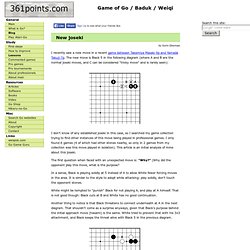

Yoda Norimoto. Yoda Norimoto (依田 紀基, born 11th February 1966) is a Japanese 9-dan professional Go player. Yoda was born in Iwamizawa, Japan. Turned professional in 1980, and promoted to 9-dan in 1993. He is known to slam go stones onto the board, even breaking them into pieces to unnerve the opponent. Previous titles include: 1983: 8th Shinjin O 1986: 11th Shinjin O 1987: 12th Shinjin O 1988: 14th Shinjin O 1990: 15th Shinjin O 1991: 38th NHK Cup 1992: 12th NEC Cup 1993: 40th NHK Cup and 5th Asian TV Cup 1995: 33rd Judan title 1996: 34th Judan and 21st Gosei titles, and 1st Samsung Cup 1997: 22nd Gosei title, 17th NEC Cup, and 4th Agon Cup 1998: 23rd Gosei title, 45th NHK Cup, and 10th Asian TV Cup 1999: 46th NHK Cup and 11th Asian TV Cup 2000: 25th Meijin and 47th NHK Cup 2001: 26th Meijin title 2002: 27th Meijin and 24th Kakusei titles, and 21st NEC Cup 2003: 28th Meijin and 28th Gosei titles 2004: 29th Gosei title 2005: 30th Gosei title Author of.
February « 2009 « 361points.com/blog. The Game of Go / Baduk / Weiqi. By Sorin Gherman I recently saw a new move in a recent game between Takemiya Masaki 9p and Yamada Takuji 7p.

The new move is Black 5 in the following diagram (where A and B are the normal joseki moves, and C can be considered "tricky move" and is rarely seen): I don't know of any established joseki in this case, so I searched my game collection trying to find other instances of this move being played in professional games. I only found 6 games (4 of which had other stones nearby, so only in 2 games from my collection was this move played in isolation).
This article is an initial analysis of mine about this joseki. The first question when faced with an unexpected move is: "Why? " In a sense, Black is playing solidly at 5 instead of A to allow White fewer forcing moves in the area. White might be tempted to "punish" Black for not playing A, and play at A himself. Another thing to notice is that Black threatens to connect underneath at A in the next diagram. Professional Game Collection. JavaGO. Takemiya Masaki. Un article de Wikipédia, l'encyclopédie libre. Takemiya Masaki Takemiya Masaki (武宮 正樹, Takemiya Masaki?) , né le 1er janvier 1951, est un joueur de go professionnel. Connu pour son style particulier à base de grands moyos, il est très populaire parmi les joueurs amateurs. Biographie[modifier | modifier le code] Takemiya Masaki est né en 1951, à Tokyo, au Japon. Fait extrêmement rare, Takemiya est également de niveau professionnel dans un autre jeu, le backgammon.
Takemiya se consacre depuis quelques années à la danse, en particulier le tango et la rumba, avec des apparitions publiques à la télévision. Go cosmique[modifier | modifier le code] Le style de Takemiya, basé sur de grands moyo centraux, est appelé « style cosmique » (宇宙流, uchūryū?). Exemple de partie contre Yoda Norimoto. Titres[modifier | modifier le code] Bibliographie[modifier | modifier le code] Takemiya Masaki. Liens externes[modifier | modifier le code]